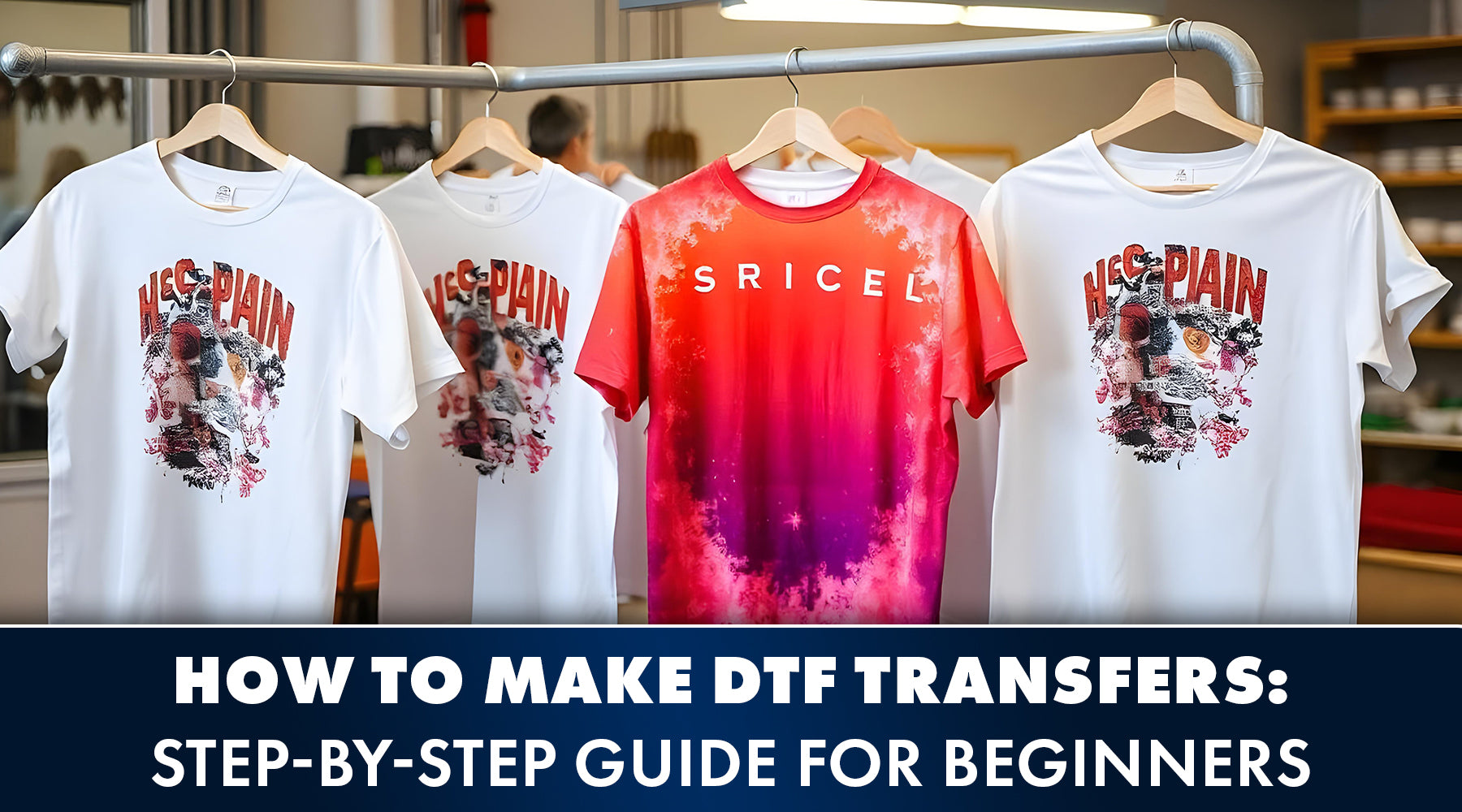A great method to make high-quality durable designs for garments is via a direct-to-film (DTF) transfer. Are you brand new to making DTF transfers or are you a seasoned printer who is adding another tool to your arsenal? Whatever the case, this guide will guide you through the step by step on how to make DTF transfers. We’ve got you covered from understanding what tools you need to the actual printing process.
What is DTF Transfer?
Direct to Film printing (DTF) printing. It is a printing of designs on special films and then transferring those films onto different fabrics. Its versatility for producing vibrant and fine detail prints makes this method preferred. In contrast to traditional techniques such as screen printing or vinyl cutting, DTF is as versatile as fabric, able to be used on many popular fabrics like cotton, polyester, or even blends.
How to Make DTF Transfers at Home
Wondering how to make DTF transfers at home? The process is almost identical to what we’ve outlined above, but there are some key points to keep in mind:
- Enjoy the satisfaction of sublimation printing or as an inkjet printer that has been adapted to DTF printing. You don’t need a DTF transfer printer, but it will simplify things.
- Because the powder adhesive can get messy, make sure you have a designated area to cure the prints.
- Pro-quality transfers require you to use a heat press at home.
Also Read: How to Make UV DTF Decals: A Step-by-Step Tutorial
What You Need to Print DTF Transfers
Before we dive into how to make DTF transfers, let’s take a look at the essential equipment you’ll need:
- DTF transfer printer: A device designed to use DTF printing. Is it possible to use a regular printer for DTF transfers? The answer is no. You’ll need to convert a standard inkjet or laser printer for DTF.
- DTF ink: It’s specially formulated ink that is really vibrant and durable when you’re transferring it to fabric.
- DTF transfer film: This film allows the design to be held before being transferred to the fabric.
- Hot melt adhesive powder: This powder applied to the printed design helps to adhere the design to the fabric when printing on top of the fabric using the heat press process.
- Heat press: To transfer the printed design from the film to the garment.
Step-by-Step Guide to Make DTF Transfers
Here’s a comprehensive guide on how to create DTF transfers:

1. Design Your Artwork
Starting is by designing your artwork using any graphic design software like Adobe Photoshop or CorelDRAW. To get the best print quality, be sure to create high-resolution images. It can be anything from logos and patterns to intricate illustrations.
Also Read: What is a DTF Printer? Understanding the Technology Behind DTF Printing
2. Print the Design on DTF Transfer Film
Print the design onto the DTF transfer film next using your DTF transfer printer. Make sure your printer has been set up to print for DTF because DTF typically requires a specific print profile. The image is printed in a mirror format so that it will print correctly onto the fabric.
3. Apply the Hot Melt Adhesive Powder
Apply the hot melt adhesive powder onto the printed design, while the ink is still wet. The wet ink pulls the powder towards it, it collects on it and it will be the glue that will stick this design to that fabric. So try to put down the powder in a uniform manner devoid of any gaps or crunches.
4. Curing the Design
The next step is to cure, the powder applied. Melt with a heat press (lower temperature) or in a curing oven the adhesive powder in the printed film. Being away from this critical step means that the adhesive will not bond appropriately to the ink.
5. Transfer the Design to the Fabric
Once your DTF transfer cures, you can transfer your DTF transfer to a fabric. Preheat your heat press to 320°F (160°C) and place the garment onto the heat press. Place the DTF transfer film onto the fabric so that the design is facing down. Put medium pressure on it for about 15-20 seconds.
6. Peel Off the Film
Wait for the garment to cool down and, being very careful, peel off the DTF transfer film. Now everything should be perfectly glued to the fabric and not fall out, with bright colors and fine details remaining.
How to Make DTF Transfers with Sublimation Printer
If you’re asking how to make DTF transfers with a sublimation printer, the answer is simple: you need to modify your sublimation printer to work with DTF ink. Here’s how:
- Instead of sublimation ink, change to DTF ink.
- Don’t use the Sublimation paper for DTF transfer film.
- You can follow the same steps mentioned above except print, apply adhesive powder, cure, and heat press.
Also Read: What Does DTF Mean in Printing? Discover the Growing Trend in Apparel Decoration
Why Choose DTF Transfers?
DTF transfers are gaining popularity for several reasons:

- Versatility: The DTF transfers can be applied to many types of fabrics including cotton, polyester, and blends.
- Durability: DTF transfers use the adhesive powder making the prints very durable and wear.
- Detail & Color: The prints that are produced through DT are very vivid and detailed and are great for such types of designs.
Conclusion
Learning how to make DTF transfers is a great way to expand your custom printing skills. Whether you're printing for fun or starting a small business, DTF transfers offer an easy and versatile solution for high-quality designs. Get started today with the right equipment and follow this guide for successful results!
Now that you know how to create DTF transfers, it’s time to start your journey! Check out DTFNC for DTF transfer. Whether you're a beginner or a seasoned pro, we have everything to make your DTF transfer printing a success!
Also Read: How to Print DTF Transfers? Learn the Correct Technique for Best Results
FAQs
How do I make my own DTF transfers?
So if you want to do your own DTF transfers you need a DTF transfer printer, DTF ink, transfer film, adhesive powder, and a heat press. Print your design to film, apply the adhesive powder, cure the print, and press it on your fabric.
What is needed to print DTF transfers?
You’ll need a DTF printer, DTF ink, special transfer film, adhesive powder, and a heat press to successfully print DTF transfers.
Can you use a regular printer for DTF transfers?
No, you cannot use a regular printer for DTF transfers unless it has been modified. A DTF transfer printer or a modified inkjet printer is required.
What are DTF transfers made of?
DTF transfers are made using special DTF ink printed onto a transfer film. The design is adhered to the fabric using an adhesive powder and heat press.
How to print DTF at home?
To print DTF at home, you’ll need a modified printer or a sublimation printer with DTF ink. Follow the standard printing and pressing process we outlined above.









10 comments
Kisha
Titoli originali su GratoWin: scopri Candy Clash e Frog Scory oggi stesso.
gratowin it
Vincite immediate su GratoWin: scopri Pyramid Spin, Gem-X e Hot Spin Retrigger.
Divertimento immediato ti aspettano. Un gioco imperdibile.
grato win
Bernd
تجربة فريدة في كازينو 888: استمتع باللعب!
casino 888 – Stuart – انضم إلى كازينو 888 اليوم
واكتشف مجموعة واسعة من الألعاب،
من الألعاب المميزة إلى الرهانات المباشرة.
لا تفوت الفرصة للعب بأمان والفوز بمكافآت رائعة!
casino 888
Oren
Na a plataforma Pagbet, as apostas são simples e entusiasmantes
pag bet aposta
Aproveite o momento com a Pagbet! Venha para nossa
plataforma, garanta bônus fantásticos, apostar nos melhores eventos.
Tudo o que você precisa para ter sucesso já está aqui!
pag bet aposta
JaredLaf
https://1xbetlklogin.com/
melbet apk bangladesh
Quite right! It is good idea. It is ready to support you.